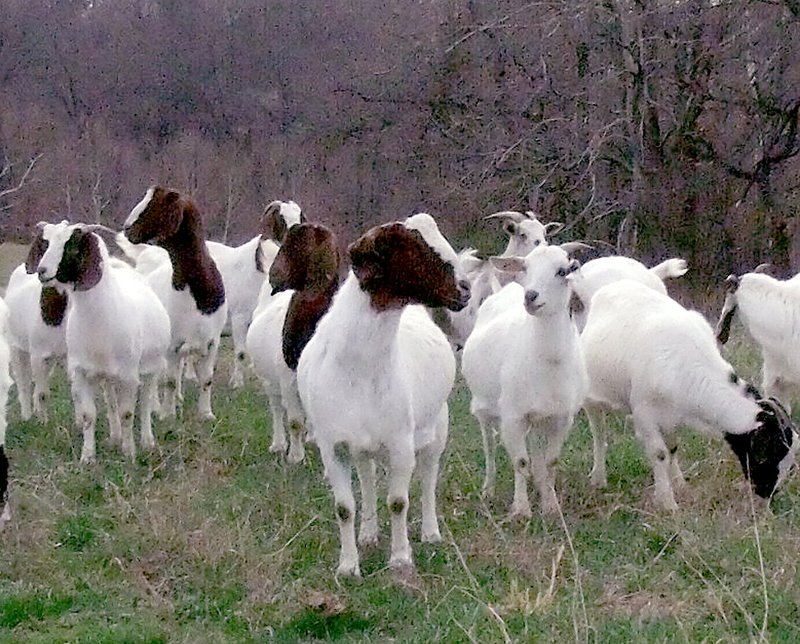Dan Frye grew up in the country and finds peace among the rolling hills on his farm southeast of Southwest City in Benton County. The old home place in Oklahoma is just two and a half miles from his current home.
Frye and his wife Lois, the city clerk for Southwest City, bought the farm in 1978, even though his job took them across the country pulling up railroad track and other scrap. It wasn't unusual for their children to be in several schools in any given year.
Frye worked for 50 years with Commercial Metals. The man who ran Commercial Metals owned the farm Frye now owns and at that time it was about 135 acres. He has since added surrounding land to increase the farm to 300 acres.
Frye knew he would return to farming and raising cattle some day, but in 1983 when Lois decided not to travel any longer and stay at the farm, he knew he would have to get another kind of livestock. Lois wasn't crazy about large livestock so he decided to buy her goats to take care of instead.
Frye is a cattle man, butdon't judge him for owning goats. They do make them a little bit of money now and again. The breed they chose to raise is Boer goats, a heavy meat goat, known for its size and weight gain.
The story goes that former veterinarian Doc Morris started artificially inseminating goats in Texas and other southern locales. He was one of the first to introduce the goats in this area.
According to an article on "Hobby Farms" website, "Boer goats were developed by Dutch stock-men in South Africa. During the early years of the 20th century, they crossed native African goats with European dairy breeds, selecting for size, meatiness, early maturity and rapid weight gain. Boer, in Dutch, means "farmer."
Boer goats are long, heavy-boned, large-framed goats with massive, meaty muscling. The obvious large ears and a Roman-nosed face are all hallmarks of the breed.
Bucks tip the scale at 250 to 350 pounds while does weigh in about 150 to 250 pounds. Both sexes have sturdy, wide-set horns that sweep gracefully back from their skulls instead of up and out like the horns of other meat goat breeds.
Frye said that the oldsaying that goats will eat anything doesn't apply to the Boer goat.
"They can be pretty particular when it comes to eating. They tend to like stemmy hay, grain and are particular about their grass," he said.
The goats go out into the pasture every morning accompanied by their guardian, Bear, a Great White Pyrenees stock dog, and return in the evening to the barn with their bellies full like chipmunks.
Goats require an overseer since by nature they tend to wander off. Most folks will use the large guard dogs, such as the Pyrenees but some people actually use llamas.
Goats of any kind require special fencing because they do tend to escape into neighboring pastures, but Frye has most of the fences lined with hog wire, which they are unable to squeeze through.
While goats may be somewhat easier to raise, Frye points out that when the kids start to arrive you need to find them and bring them in because the nanny's lose them in the tall grass or another nanny will be aggressive to a kid that is not her own.
The gestation period for these goats is 150 days, plus two weeks to make sure they are all bred. The Frye's feed the nanny's grain several days before the billy is turned in so that they are very fertile.
Boer does are prolific moms often having twins, but triplets and quads are common. Their milk is rich and high in butterfat. Unlike other goats, many Boer does have four functional teats. Market kids often command premium prices when sold at auction, making Boers and Boer-crosses the best bet for commercial production.
Cooler weather also helps them come into heat and if you don't want back to back birthing, you need to pull the billy out of the pasture or sell him because nanny's come back in heat just 10 days after giving birth.
The Fryes currently have 29 nannies and one billy. Last year five of their nanny's had triplets.
They take most of their goats to the sale barn to be auctioned off, but they do sell a lot of weanling kids to the large Hispanic population of the area. They get around $50 for a weaned kid and around $1.50 a pound at the sale barn.
Many of the Hispanics use the tender meat for various holidays and celebrations throughout the year. However, goats that are sold at the sale barn head to Texas to become meat for various frozen pizza companies.
Even though Dan retired in 2012, he admits that he misses the camaraderie of the men he worked with, but he doesn't miss the miles on the road away from home.
He adds that between the cows, which is his mainstay, the goats, haying and keeping the weeds knocked down, he logs quite a few miles in his retirement.
He grins as he passes on a piece of advice for haying in the Ozarks hills.
"Always be careful when you're haying on top of a hill and take note which direction you kick the bale out," he said. "I was haying on that hill over there behind our neighbors house and kicked a bale out. Before I knew it that bale went rolling down that hill. I kept hoping it would get stopped by a tree but it blasted right on through."
Then, in his slow manner, he states matter-of-factly that it miraculously came to a halt about 50 feet from his neighbors' house.
General News on 04/16/2014
